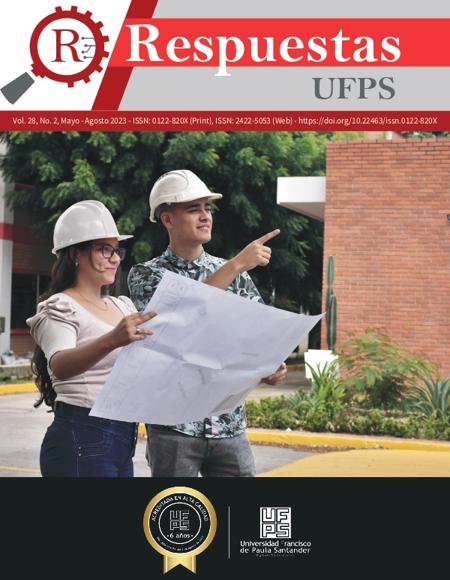La técnica TOPSIS de selección de proveedores en un caso de estudio en la Industria Maquiladora de Ciudad Juárez
TOPSIS technique supplier selection in a case study in the Maquiladora Industry in Ciudad Juarez
Contenido principal del artículo
Con el uso de este método se demostró la importancia que tiene para la empresa la selección de un proveedor a la hora de solicitar o pedir materia prima. Se aplicó la metodología Topsis ya que es un método práctico y es el que mejor se adapta para resolver este problema. Al momento, de aplicar esta metodología, generamos cuales son los niveles de importancia que la empresa solicita para seleccionar uno de ellos, más que nada son factores o puntos que cada empresa elige para un mejor manejo de sus recursos, cuidando así la parte de tiempo y dinero. En la industria donde se hará esta observación, los principales niveles de importancia solicitados son los siguientes: Calidad, Tiempo, Precio y Fiabilidad del proveedor.
Descargas
Detalles del artículo
R. M. Ilyas, D. K. Banwet, and R. Shankar, “Value Chain Relationship - A Strategy Matrix,” Supply Chain Forum An Int. J., vol. 8, no. 1, pp. 56–72, 2007, doi: 10.1080/16258312.2007.11517176.
J. DeBoer, R. Panwar, and J. Rivera, “Toward A Place-Based Understanding of Business Sustainability: The Role of Green Competitors and Green Locales in Firms’ Voluntary Environmental Engagement,” Bus. Strateg. Environ., vol. 26, no. 7, pp. 940–955, 2017, doi: 10.1002/bse.1957.
A. Meyer, W. Niemann, and K. Peckover, “Supply Chain Agility: a Conceptual Framework Towards Leagility,” 1st African Oper. Manag. Conf., pp. 1–16, 2017.
C. N. Wang, V. T. Nguyen, H. T. N. Thai, N. N. Tran, and T. L. A. Tran, “Sustainable supplier selection process in edible oil production by a hybrid fuzzy analytical hierarchy process and green data envelopment analysis for the SMEs food processing industry,” Mathematics, vol. 6, no. 12, 2018, doi: 10.3390/math6120302.
B. GÜRSOY, “Modelling of just-in-time distrubution network under raw material quality and time constraints,” Sigma J. Eng. Nat. Sci. – Sigma Mühendislik ve Fen Bilim. Derg., vol. 39, no. 3, pp. 313–321, 2021, doi: 10.14744/sigma.2021.00019.
H. Fatorachian and H. Kazemi, “Impact of Industry 4.0 on supply chain performance,” Prod. Plan. Control, vol. 32, no. 1, pp. 63–81, 2021, doi: 10.1080/09537287.2020.1712487.
M. Obeso, R. Hernández-Linares, M. C. López-Fernández, and A. M. Serrano-Bedia, “Knowledge management processes and organizational performance: the mediating role of organizational learning,” J. Knowl. Manag., vol. 24, no. 8, pp. 1859–1880, 2020, doi: 10.1108/JKM-10-2019-0553.
O. Morell-Santandreu, C. Santandreu-Mascarell, and J. García-Sabater, “Sustainability and kaizen: Business model trends in healthcare,” Sustain., vol. 12, no. 24, pp. 1–28, 2020, doi: 10.3390/su122410622.
R. E. Gergin, I. Peker, and A. C. G. Kısa, “Supplier Selection By Integrated Ifdematel-Iftopsis Method: a Case Study of Automotive Supply Industry,” Decis. Mak. Appl. Manag. Eng., vol. 5, no. 1, pp. 169–193, 2022, doi: 10.31181/dmame211221075g.
A. Fallahpour, K. Y. Wong, S. Rajoo, A. M. Fathollahi-Fard, J. Antucheviciene, and S. Nayeri, “An integrated approach for a sustainable supplier selection based on Industry 4.0 concept,” Environ. Sci. Pollut. Res., p. 4, 2021, doi: 10.1007/s11356-021-17445-y.
A. Paulraj, I. J. Chen, and C. Blome, “Motives and Performance Outcomes of Sustainable Supply Chain Management Practices: A Multi-theoretical Perspective,” J. Bus. Ethics, vol. 145, no. 2, pp. 239–258, 2017, doi: 10.1007/s10551-015-2857-0.
E. M. Frazzon, C. M. T. Rodriguez, M. M. Pereira, M. C. Pires, and I. Uhlmann, “Towards Supply Chain Management 4.0,” Brazilian J. Oper. Prod. Manag., vol. 16, no. 2, pp. 180–191, 2019, doi: 10.14488/bjopm.2019.v16.n2.a2.
C. T. Chen, C. T. Lin, and S. F. Huang, “A fuzzy approach for supplier evaluation and selection in supply chain management,” Int. J. Prod. Econ., vol. 102, no. 2, pp. 289–301, 2006, doi: 10.1016/j.ijpe.2005.03.009.
S. Enginoğlu, F. Karaaslan, and S. Memiş, “A new approach to group decision-making method based on TOPSIS under fuzzy soft environment,” J. New Results Sci., vol. 8, no. 2, pp. 42–52, 2019.
M. Keshavarz-Ghorabaee, M. Amiri, E. K. Zavadskas, Z. Turskis, and J. Antucheviciene, “A comparative analysis of the rank reversal phenomenon in the EDAS and TOPSIS methods,” Econ. Comput. Econ. Cybern. Stud. Res., vol. 52, no. 3, pp. 121–134, 2018, doi: 10.24818/18423264/52.3.18.08.
X. Liu and L. Wang, “An extension approach of TOPSIS method with OWAD operator for multiple criteria decision-making,” Granul. Comput., vol. 5, no. 1, pp. 135–148, 2020, doi: 10.1007/s41066-018-0131-4.
R. Depczynski, “MCDA based approach to supplier evaluation - Steel industry enterprise case study,” Procedia Comput. Sci., vol. 192, pp. 5081–5092, 2021, doi: 10.1016/j.procs.2021.09.286.
H. Gupta and M. K. Barua, “Supplier selection among SMEs on the basis of their green innovation ability using BWM and fuzzy TOPSIS,” J. Clean. Prod., vol. 152, pp. 242–258, 2017, doi: 10.1016/j.jclepro.2017.03.125.
J. Hu, Y. Du, H. Mo, D. Wei, and Y. Deng, “A modified weighted TOPSIS to identify influential nodes in complex networks,” Phys. A Stat. Mech. its Appl., vol. 444, no. xxxx, pp. 73–85, 2016, doi: 10.1016/j.physa.2015.09.028.
R. Manickam, “Prediction of Hybrid Wind Farms using Fuzzy TOPSIS Analysis,” REST J. Emerg. trends Model. Manuf., vol. 8, no. 2, pp. 68–75, 2022, doi: 10.46632/jemm/8/2/2.







